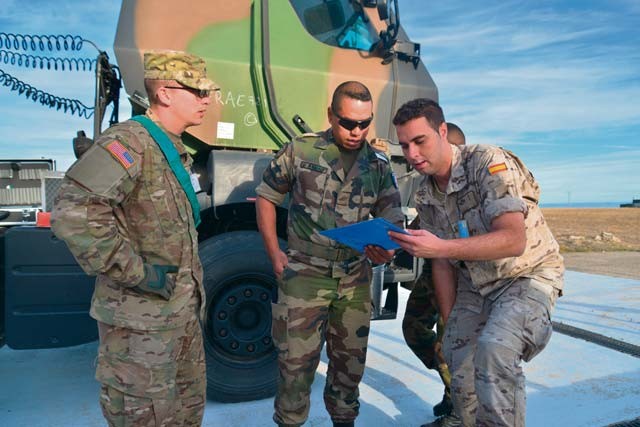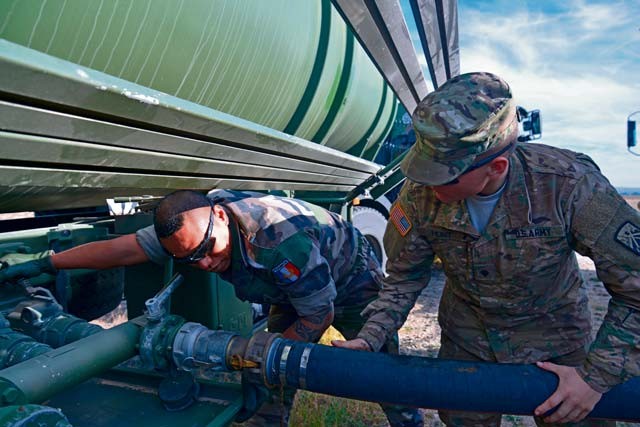
U.S. Army Sgt. Daryl Perez (left), French Petroleum, Oil and Lubrication Cpl. John Parau (center) and Spanish Air Force Pvt. Alejandro Sanudo, all members of Trident Juncture 2015’s modular combined petroleum unit, coordinate exercise logistics Oct. 8 in Zaragoza, Spain. The MCPU fueled vehicles from nearly all of the 35 participating countries during the exercise.
As the largest NATO training exercise in more than a decade culminated in an international combined arms offensive punctuated by an air assault by 82nd Airborne Division paratroopers, the logisticians, planners, movement controllers, fuel handlers, mechanics and medics of the 21st Theater Sustainment Command worked as feverishly on redeployment as they had on the original deployment of allied forces, weapons systems and gear over the weeks and months preceding the massive mission.
Transportation troops and support Soldiers of the 16th Sustainment Brigade and personnel from the 30th Medical Brigade’s 421st Multifunctional Medical Battalion spearheaded the 21st TSC’s exercise efforts throughout Trident Juncture 2015.
While aviators, paratroopers, weapons systems and combat troops captured headlines and imaginations across the continent, sustainment personnel conducted essential validating operations alongside allies, building vital relationships and putting interoperability concepts to the toughest of tests. Meanwhile, combat medics and medical support personnel from the 30th Med. Bde. not only provided services but conducted tough, realistic training across national and cultural lines as well as in linguistics. With health, safety and even lives potentially at stake, effective coordination and communication were literally a life and death matter for allied medics.
The 515th Transportation Company of the 16th SB’s 39th Transportation Battalion played an energetic organizational role in the reception, staging, onward movement and integration mission.
“Coordinating the deployment and redeployment of the units participating in Trident Juncture was our mission — working in small teams at several locations in Spain, Portugal, and Italy,” said 1st Lt. Spencer Bolduc, the 635th Movement Control Team executive officer. “Working alongside Spanish movement control counterparts really helped expand our understanding of the organization of large-scale multinational movements. It provided our unit a chance to learn new systems that are designed to simplify logistics coordination within NATO.”
While movement controllers coordinated major transportation missions with allied counterparts, fuel handlers, mechanics and technicians demonstrated an impressive degree of international
operational interoperability.
“Before the exercise, the Soldiers were unsure about how well the equipment would work and how other nations’ fuel specialists could work on it,” said 1st Lt. Stephanie Hasenfus, a platoon leader with the 515th Trans. “After 40 days of working together though, it is great to see how well they adapted and built trust with our partners in the petroleum unit.”
The support Soldiers and medics gained invaluable operational and practical experience during the exercise. They built even more valuable rapport with allies and partners.
“It was an incredible experience working under a Spanish command element,” said Sgt. 1st Class Shalayne Tucker of the 1st Inland Cargo Transfer Company. “They took great care of us, and we learned a lot working with them as well as other forces like Italian, French, British and Canadian.
“Communication was a barrier we overcame easily because so many Soldiers spoke Spanish and have been able to work as translators,” Tucker continued. “In addition to ensuring all the equipment was received and staged for the exercise, we got the opportunity to learn so much about other cultures and build connections and relationships that will go beyond the end of the exercise.”
Precise planning, preparation, coordination and movement, across linguistic and cultural as well as geographic terrain, preceded every successful operation. Delivery of appropriate equipment, supplies, vehicles, weapons systems, ammunition, food and fuel — not to mention the troops themselves — to the right place at the right time is a remarkable achievement even for a single large organization. To do so skillfully across a wide array of formations, commands, organizations, services and countries is graduate-level logistics.
“Trident Juncture posed enormous logistical challenges for our enablers, and we met every one of them,” said Lt. Col. Donald E. Peters, 21st TSC lead spokesman. “The scale and scope of the forces involved and the varied missions they accomplished demanded robust, flexible support over weeks and months. The integration with allied leaders, logisticians and technicians was so complete as to demand precise synchronization of every significant plan, decision and large-scale movement.
“This was among the most powerful demonstrations of international theater logistics capabilities in recent European history,” Peters added. “It’s truly amazing what our allied logisticians can achieve.”
Around 36,000 personnel from over 30 nations participated in Trident Juncture 2015. The exercise was conducted primarily in Spain, Portugal and Italy with additional activities in Belgium, Canada, Germany, the Netherlands and Norway as well as maritime operations in the Atlantic Ocean and Mediterranean Sea.



